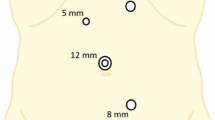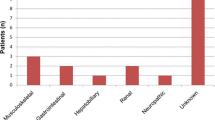Abstract
Robot-assisted pyeloplasty (RAP) is emerging as an effective tool for treatment of ureteropelvic junction obstruction (UPJO) in the pediatric population. Typically stents are utilized for RAP and removed four weeks after the procedure. We present our prospective experience with stentless RAP. Twenty children between the ages of 12 and 113 months (mean age 56 months) underwent transperitoneal RAP for UPJO utilizing the DaVinci surgical system. Outcome measures included operative time, length of hospital stay, and resolution of obstruction by ultrasonography, magnetic resonance urography (MRU), and/or diuretic radionuclide imaging (DRI). All patients successfully underwent robot-assisted laparoscopic pyeloplasty without conversion to pure laparoscopy or open procedure. Mean operative time was 124.7 min with a mean console time of 82.3 min. The mean hospital stay was 18 h. Of the 20 patients, 13/20 (65%) had resolution or improvement in the degree of hydronephrosis. The other patients had no evidence of obstruction based upon follow-up MRU or DRI. Stentless RAP is a safe and effective option for surgical treatment of UPJO. A larger prospective long-term cohort is needed to confirm the safety and efficacy of the stentless approach.


Similar content being viewed by others
References
Lee DI, Eichel L, Skarecky DW, Ahlering TE (2004) Robotic laparoscopic radical prostatectomy with a single assistant. Urology 63(6):1172–1175
Atug F, Woods M, Burgess SV, Castle EP, Thomas R (2005) Robotic assisted laparoscopic pyeloplasty in children. J Urol 174(4 Pt 1):1440–1442
Lee RS, Retik AB, Borer JG, Peters CA (2006) Pediatric robot assisted laparoscopic dismembered pyeloplasty: comparison with a cohort of open surgery. J Urol 175(2):683–687 (discussion 687)
Kutikov A, Resnick M, Casale P (2006) Laparoscopic pyeloplasty in the infant younger than 6 months—is it technically possible? J Urol 175(4):1477–1479
Casale P (2009) Robotic pyeloplasty in the pediatric population (review). Curr Opin Urol 19(1):97–101
Kavoussi LR, Peters CA (1993) Laparoscopic pyeloplasty. J Urol 150:1891
Casale P (2008) Robotic pediatric urology (review). Expert Rev Med Devices 5(1):59–64
Author information
Authors and Affiliations
Corresponding author
Rights and permissions
About this article
Cite this article
Casale, P., Lambert, S. Prospective analysis of completely stentless robot-assisted pyeloplasty in children. J Robotic Surg 3, 215–217 (2010). https://doi.org/10.1007/s11701-009-0164-4
Received:
Accepted:
Published:
Issue Date:
DOI: https://doi.org/10.1007/s11701-009-0164-4




